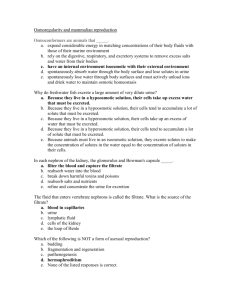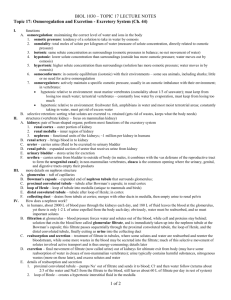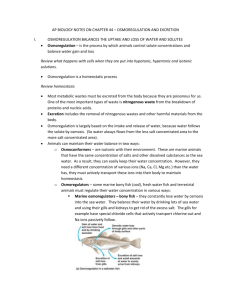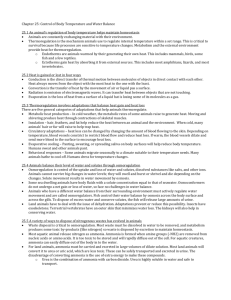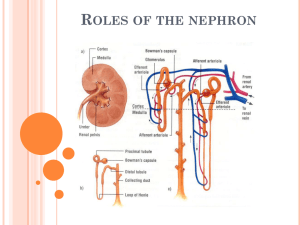Chapter 38 WATER AND ELECTROLYTE BALANCE IN ANIMALS
advertisement
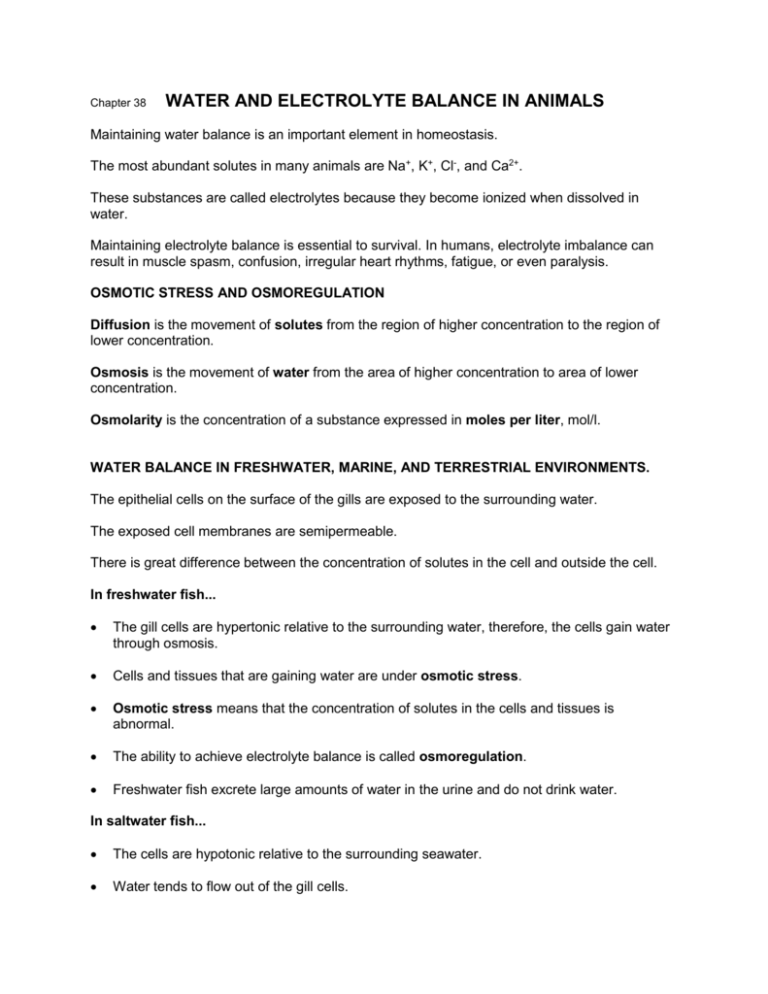
Chapter 38 WATER AND ELECTROLYTE BALANCE IN ANIMALS Maintaining water balance is an important element in homeostasis. The most abundant solutes in many animals are Na+, K+, Cl-, and Ca2+. These substances are called electrolytes because they become ionized when dissolved in water. Maintaining electrolyte balance is essential to survival. In humans, electrolyte imbalance can result in muscle spasm, confusion, irregular heart rhythms, fatigue, or even paralysis. OSMOTIC STRESS AND OSMOREGULATION Diffusion is the movement of solutes from the region of higher concentration to the region of lower concentration. Osmosis is the movement of water from the area of higher concentration to area of lower concentration. Osmolarity is the concentration of a substance expressed in moles per liter, mol/l. WATER BALANCE IN FRESHWATER, MARINE, AND TERRESTRIAL ENVIRONMENTS. The epithelial cells on the surface of the gills are exposed to the surrounding water. The exposed cell membranes are semipermeable. There is great difference between the concentration of solutes in the cell and outside the cell. In freshwater fish... The gill cells are hypertonic relative to the surrounding water, therefore, the cells gain water through osmosis. Cells and tissues that are gaining water are under osmotic stress. Osmotic stress means that the concentration of solutes in the cells and tissues is abnormal. The ability to achieve electrolyte balance is called osmoregulation. Freshwater fish excrete large amounts of water in the urine and do not drink water. In saltwater fish... The cells are hypotonic relative to the surrounding seawater. Water tends to flow out of the gill cells. The cells run the risk of plasmolysis, which is shriveling and dying. Saltwater fish secrete large amounts of salt and drink lots of water. Land animals... Land animals constantly lose water to the environment through evaporation. Gas exchange occurs through the wet surfaces of the lung epithelium. Sweating and panting in order to keep their body cool also loses water. Electrolyte balance in freshwater, marine and terrestrial environments. 1. In freshwater fish... Freshwater is hypotonic to the cell. Ions tend to move out of the cell into the surrounding water. Electrolytes lost must be replace by eating and by active transport from the surrounding water. 2. In saltwater fish... Seawater is hypertonic to the cells. Ions move in from the surrounding water. Most of this gain occurs in the gills. They also obtain many ions in their food and in the water they drink. Excess ions must secreted. 3. Land animals... Land animals gain electrolytes in food and lose electrolytes in sweat. Depending on conditions at the time, land animals must conserve or excrete electrolytes to maintain homeostasis. Water and electrolyte balance in aquatic environments. Shark rectal gland Shark tissues are isotonic to the saltwater. The cells and extracellular fluids contain large amounts of urea and trimethylamine oxide (TMAO), and moderate concentrations of sodium, potassium and chloride. Sharks still have to excrete sodium and chloride because these substances diffuse through the gills. Sodium-potassium pumps are located on the basolateral side of epithelial cells in this gland. These pumps establish an electrochemical gradient that carries Na+ and Cl- from the blood into the lumen of the gland where it is excreted. The role of Na+/K+-ATPase Na+/K+-ATPase is found in the membranes of the epithelial cells lining the lumen of the shark's rectal gland. Na+/K+-ATPase pumps Na+ out of the cells and K+ into the cell. This activity creates an electrochemical gradient that favors the diffusion of Na+ back into the cell. Cotransporters are membrane proteins that transport more than one type of ions. A Na+/Cl- cotransporter brings these two ions from the extracellular fluid into the epithelial cells across their basolateral surfaces. Na+ are pumped back out of the cell. Cl- ions build up inside the cell. A chloride channel located in the apical membrane of the epithelial cells (facing the lumen) allows Cl- to diffuse out along its concentration gradient. Na+ diffuse into the lumen of the gland, following the concentration gradient by passing in between the spaces between the cells. The solution in the lumen, the interior cavity of the gland, empties into the environment. The mechanism just described is widespread in animals. Marine birds and reptiles have salt-excreting glands in their nostrils. These glands function much like the shark rectal gland. Salt constantly diffuses into the cells of the gills of marine fishes. The cells are hypotonic to the salt water. Specialized salt-excreting cells similar to those found in the rectal gland, are found in the epithelium of the gills. These cells excrete excess salt. The kidneys of mammals have cells with pumps, cotransporters and channels, which transport salt out of the kidney. Osmoregulation in salmons Freshwater fish do not drink and secrete large amounts of diluted urine. Studies have shown that salmon species have two populations of cells in their gills Individuals living in saltwater have a large population of chloride-excreting cells at the base of the gill filaments. Salmon living in fresh water had salt-excreting cells in the lamellae that extend from the gill filaments. Salmon migrating into saltwater showed chloride-excreting cells at the base of the gill filaments. Salmon migrating into freshwater showed an increase of chloride-excreting cells in the gill lamellae. The chloride-cell-switch hypothesis implies that salmon sense changes in the osmolarity of their environment and respond by producing or destroying the appropriate populations of chloride cells. The actual mechanism is still to be elucidated. WATER AND ELECTROLYTE BALANCE IN TERRESTRIAL INVERTEBRATES. Invertebrates living in dry environment rarely drink water and are under water stress. Insects minimize water loss from their body surface Water loss is a byproduct of respiration. Their exoskeleton is covered with a waxy substance that prevents evaporations. The waxy layer is made of nitrogen-containing polysaccharides called chitin, and proteins. Insects have a tracheal system of tubes used in respiration. This system connects to the atmosphere through openings called spiracles. Muscles just inside the spiracle can open or close the pore depending on the atmospheric conditions. Types of nitrogenous wastes. Nitrogenous wastes are the products of deamination of amino acids. Ammonia is highly toxic and it is usually converted to uric acid or urea. Uric acid is the product of nucleic acid and amino acid breakdown. It is excreted in the form of a crystalline paste with little water loss. Birds, insects and some reptile excrete uric acid. Amphibians and mammals excrete urea. The type of waste excrete by animals is correlated to the amount of water stress the animal has to endure. Animals living in dry habitats secrete uric acid because they must conserve water. The excretory system To maintain homeostasis, insects must regulate the electrolyte balance in their blood-like fluid called hemolymph. Nutrients pass from the hemolymph into the cells and nitrogenous wastes pass from the cell to the hemolymph. Malpighian tubules are found insects and spiders. Blind end tubules that stretch into the hemocoel, the body cavity. Their cells transfer wastes and salts from the hemolymph to the lumen of the tubule by diffusion and active transport. They empty into the intestine. Water and some salts are reabsorbed. K+ concentration inside the tubules is high compared to the hemolymph. K+ accumulate against the concentration gradient. The high concentration of potassium brings water into the tubules by osmosis. The "pre-urine" in the tubules flows into the hindgut where it mixes with the material coming from the anterior digestive tract. A large amount of water is reabsorbed in this part of the gut and the urine becomes very concentrated. In desert species up to 95% of the water is reabsorbed. Na+/K+-ATPase moves ions from the lumen of the gut into the hemolymph. There are also chloride pumps that transport Cl- against the concentration gradient. The formation of the pre-urine is not selective, however, the formation of the urine through reabsorption is highly selective. Water and electrolytes are reabsorbed in order to maintain homeostasis. Waste products do not pass through the rectal membrane back into the hemolymph but remain in the urine and feces. WATER AND ELECTROLYTE BALANCE IN TERRESTRIAL VERTEBRATES. The functions of the excretory system are Regulation of body fluids by osmoregulation. Excretion of metabolic waste. The body maintains a constant osmotic pressure by actively regulating the concentration of solutes in the body fluids: osmoregulation. Excretion is the process of ridding the body of metabolic wastes including water. It is different from elimination of feces or defecation. MAMMALIAN URINARY SYSTEM Kidney produces urine. Ureter brings urine to the urinary bladder. Urinary bladder stores urine temporarily. Urethra leads the urine to the outside. The outer region of the kidney is called the renal cortex and the inner region the renal medulla. The renal medulla contains a number of cone-shaped structures called renal pyramids. At the tip of each renal pyramid is a renal papilla into which the collecting ducts open. The renal pelvis is a pyramidal chamber that collects and leads the urine to the ureter. The nephron is the functional unit of the kidney. 1. The filtrate passes from capillaries Bowman's capsule proximal convoluted tubule loop of Henle distal convoluted tubule collecting duct renal pelvis. 2. Blood circulates through the kidney in the following sequence: Renal artery afferent arteriole capillaries of glomerulus efferent arteriole peritubular capillaries small veins renal veins. 3. Filtration, reabsorption and secretion produce urine. Filtration is not selective with regard to ions and small molecules. Reabsorption is highly selective. Some substances are actively secreted from the blood. Hydrostatic pressure in glomerular capillaries is higher than in other capillaries. Efferent arteriole is smaller than the afferent arteriole. The high pressure forces about 10% of the plasma out of the capillaries into Bowman's capsule. Glomerular capillaries are highly permeable with numerous small pores (fenestration) present between the endothelial cells. There is a large permeable surface provided by the highly coiled capillaries. Capillary epithelium and podocytes make up the filtration membrane. Podocytes make the wall of Bowman's capsule and have elongated processes ("feet") which cover the surface of most capillaries. Filtration slits separate the foot processes of adjacent podocytes. The force to perform filtration comes from the blood pressure created by the heart and the closed circulatory system of vertebrates. The filtration membrane holds back large proteins and RBCs. Glucose, amino acids, ions and urea pass through and become part of the filtrate. Reabsorption is highly selective. The proximal tubule is involved in the active transport of molecules in and out of the filtrate. Microvilli are present on the epithelial cells facing the lumen side. Some substances are actively secreted from the blood into the filtrate. Hydrogen, ammonium and potassium ions are actively secreted when their concentration is too high. Filtrate is concentrated as it passes through the renal tubule. The process depends on the salt concentration in the interstitial fluid in the kidney medulla. The interstitial fluid has higher salt concentration around the loop of Henle. There is a counterflow of fluid through the two limbs of the loop of Henle. Water is drawn by osmosis from the filtrate as it passes through the collecting ducts and it concentrates the filtrate. Mechanism: reabsorption in the proximal tubule. The microvilli in the apical membrane contain several cotransporters and pumps including Na+/K+-ATPase. Na+/K+-ATPase in the basolateral membrane, facing the blood vessels near the proximal tubule, pumps Na+ from the cell into the capillaries. This creates a strong concentration gradient that brings Na+ into the cell from the filtrate, by means of cotransporters. These cotransporters bind Na+ to glucose, amino acids or Cl-. The binding of sodium to these molecules allows them to flow into the cells against the concentration gradient. Water follows the ions by osmosis. Water leaves the proximal tubule through membrane proteins called aquaporins. Osmotic gradient in the loop of Henle. The filtrate then passes from the proximal tubule to the loop of Henle. The osmolarity is low in the cortex of the kidney and high in the medulla. The osmolarity in the tissues surrounding the loop of Henle mirrors the osmolarity inside the tubule. There is a strong gradient between the two regions. The descending portion of the loop is highly permeable to water but the ascending portion of the loop is impermeable to water. The filtrate becomes more and more concentrated as it descends. In the thin portion of the ascending limb, Na+ and Cl- are reabsorbed. These ions flow out of the tubule following the concentration gradient. Na+ and Cl- are actively transported out of the thicker upper portion of the tubule. Capillaries known as the vasa recta remove some of the water that diffuses from the filtrate into the interstitial fluid. The vasa recta are extensions of the efferent arteriole that extend deeply into the medulla and then return fluid to the veins draining the kidney. Urine is about 96% water, 2.5% urea, 1.5% salts and traces of other substances. Urinalysis is the physical, chemical and microscopic examination of urine. Filtration rate: 180 liter/day (45 gallons/day). About 1.5 liter of urine is excrete every 24 hours. The rest of the fluid, about 99% of filtrate, is reabsorbed. Urine volume is regulated by the hormone ADH (antidiuretic hormone), which is released by the posterior lobe of the pituitary gland in response to an increase in osmotic concentration of the blood, caused by dehydration. Low fluid intake decreases blood volume and increase osmotic pressure of blood. ADH increases the permeability of collecting ducts to water, increasing reabsorption and decreasing water excretion. Aldosterone increases sodium reabsorption by distal and collecting ducts. Sodium is the most abundant extracellular ion. It is produced by the adrenal gland as a reaction to a drop in blood pressure. Decrease on blood pressure is caused by a decrease in blood volume due to dehydration.


